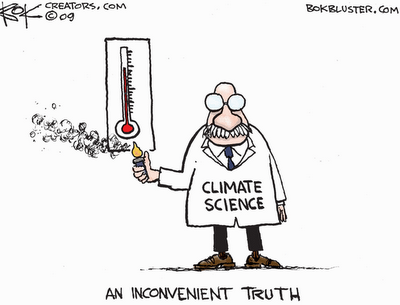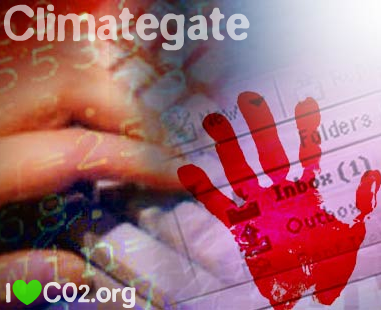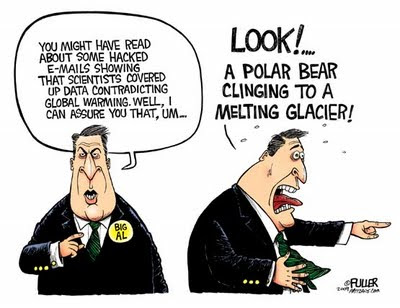It was presented as fact. The UN’s Intergovernmental Panel on Climate Change, led by India’s very own RK Pachauri, even announced a consensus on it. The world was heating up and humans were to blame. A pack of lies, it turns out.
If I had a world of my own, everything would be nonsense. Nothing would be what it is, because everything would be what it isn’t. And contrarywise, what is, it wouldn’t be. And what it wouldn’t be, it would. You see? —Alice in Wonderland The climate change fraud that is now unravelling is unprecedented in its deceit, unmatched in scope—and for the liberal elite, akin to 9 on the Richter scale. Never have so few fooled so many for so long, ever. The entire world was being asked to change the way it lives on the basis of pure hyperbole. Propriety, probity and transparency were routinely sacrificed. The truth is: the world is not heating up in any significant way. Neither are the Himalayan glaciers going to melt as claimed by 2035. Nor is there any link at all between natural disasters such as Hurricane Katrina and global warming. All that was pure nonsense, or if you like, ‘no-science’!
The climate change mafia, led by Dr Rajendra K Pachauri, chairperson of the Intergovernmental Panel on Climate Change (IPCC), almost pulled off the heist of the century through fraudulent data and suppression of procedure. All the while, they were cornering millions of dollars in research grants that heaped one convenient untruth upon another. And as if the money wasn’t enough, the Nobel Committee decided they should have the coveted Peace Prize. But let’s begin at the beginning. Mr Pachauri has no training whatsoever in climate science. This was known all the time, yet he heads the pontification panel which proliferates the new gospel of a hotter world. How come? Why did the United Nations not choose someone who was competent? After all, this man is presumably incapable of differentiating between ocean sediments and coral terrestrial deposits, nor can he go about analysing tree ring records and so on. That’s not jargon; these are essential elements of a syllabus in any basic course on climatology.
You cannot blame him. His degree and training is in railroad engineering. You read it right. This man was educated to make railroads from point A to point B.
THE GATHERING STORM
There are many casualties in this sad story of greed and hubris. The big victim is the scientific method. This was pointed out in great detail by John P Costella of the Virginia-based Science and Public Policy Institute. Science is based on three fundamental pillars. The first is fallibility. The fact that you can be wrong, and if so proven by experimental input, any hypothesis can be—indeed, must be—corrected. This was systematically stymied as early as 2004 by the scientific in-charge of the University of East Anglia’s Climate Change Unit. This university was at the epicentre of the ‘research’ on global warming. It is here that Professor Phil Jones kept inconvenient details that contradicted climate change claims out of reports. The second pillar of science is that by its very nature, science is impersonal. There is no ‘us’, there is no ‘them’. There is only the quest. However, in the entire murky non-scientific global warming episode, if anyone was a sceptic he was labelled as one of ‘them’. At the very apex, before his humiliating retraction, Pachauri had dismissed a report by Indian scientists on glaciers as “voodoo science”. The third pillar of science is peer group assessment. This allows for validation of your thesis by fellow scientists and is usually done in confidence. However, the entire process was set aside by the IPCC while preparing the report. Thus, it has zero scientific value. The fact that there was dissent within the climate science teams, that some people objected to the very basis of the grand claims of global warming, did not come out through the due process. It came to light when emails at the Climate Research Centre at East Anglia were hacked in November 2009. It is from the hacked conversations that a pattern of conspiracy and deceit emerge. It is a peek into the world of global warming scaremongering—amplify the impact of CO2, stick to dramatic timelines on destruction of forests, and never ask for a referral or raise a contrary point. You were either a believer in a hotter world or not welcome in this ‘scientific fold’.
HOUSE OF CARDS AND COLOUR OF CASH
So we have the fact that a non-expert heads the IPCC. We have the fact that glaciers are not melting by 2035; this major scaremongering is now being defended as a minor error (it was originally meant to be 2350, some have clarified). The date was spouted first by Syed Hasnain, an Indian glacier expert, in an interview to a magazine. It had no scientific validity, and, as Hasnain has himself said, was speculative. On the basis of that assertion, The Energy and Resources Institute (Teri) that Pachauri heads and where Hasnain works in the glaciology team, got two massive chunks of funding. The first was estimated to be a $300,000 grant from Carnegie Corporation and the second was a part of the $2 million funding from the European Union. So you write a report that is false on glaciers melting and get millions to study the impact of a meltdown which will not be happening in the first place. Now if this is not a neat one, what is? The same goes for dire predictions on Amazon rain forests. The IPCC maintained that there would be a huge depletion in Amazon rain forests because of lack of precipitation. Needless to add, no Amazon rain forest expert could be trusted to back this claim. They depended on a report by a freelance journalist and activist, instead, and now it has blown up in their faces. There’s plenty more in this sordid tale. For one thing, there is no scientific consensus at all that man-made CO2 emissions cause global warming, as claimed by the IPCC. In a recent paper, Lord Monckton of Brenchley, who has worked extensively on climate change models, argues: ‘There is no scientific consensus on how much the world has warmed or will warm; how much of the warming is natural; how much impact greenhouse gases have had or will have on temperature; how sea level, storms, droughts, floods, flora, and fauna will respond to warmer temperature; what mitigative steps—if any—we should take; whether (if at all) such steps would have sufficient (or any) climatic effect; or even whether we should take any steps at all.’ An investigation by Dr Benny Peiser, director, Global Warming Policy Foundation, has revealed that only 13 of the 1,117, or a mere 1 per cent of the scientific papers crosschecked by him, explicitly endorse the consensus as defined by the IPCC. Thus the very basis of the claim of consensus on global warming is false. And so deeply entrenched is the global warming lobby, the prestigious journal Science did not publish a letter that Dr Peiser wrote pointing out the lack of consensus. Speaking to Open, says Dr Peiser, “The IPCC process by which it arrives at its conclusions lacks balance, transparency and due diligence. It is controlled by a tightly knit group of individuals who are completely convinced that they are right. As a result, conflicting data and evidence, even if published in peer-reviewed journals, are regularly ignored, while exaggerated claims, even if contentious or not peer-reviewed, are often highlighted in IPCC reports. Not surprisingly, the IPCC has lost a lot of credibility in recent years. It is also losing the trust of more and more governments who are no longer following its advice. Until it agrees to undergo a root and branch reform, it will continue to haemorrhage credibility and trust. The time has come for a complete overhaul of its structure and workings.” Another fraud is in the very chart central to Pachauri’s speech at the Copenhagen summit. As Lord Monckton has pointed out, ‘The graph is bogus not only because it relies on made-up data from the Climate Research Unit at the University of East Anglia, but also because it is overlain by four separate trendlines, each with a start-date carefully selected to give the entirely false impression that the rate of warming over the past 150 years has itself been accelerating, especially between 1975 and 1998. The truth, however—neatly obscured by an ingenious rescaling of the graph and the superimposition of the four bogus trend lines on it—is that from 1860 to 1880 and again from 1910 to 1940 the warming rate was exactly the same as the warming rate from 1975 to 1998.’
PACHAURI’S WRONG NUMBERS
 This chart, tracking mean global temperature over the past 150 years, was central to the presentation that IPCC Chairman Rajendra K. Pachauri made at the Copenhagen environment summit. Many scientists believe that the graph is fraudulent. First, there are strong allegations that the data, collected from the Climate Research Unit at the University of East Anglia, is a tissue of lies. Plus, as British climate change expert Lord Christopher Monckton puts it: “(The main graph, in darker blue) is overlain by four separate lines, each carefully selected to give the entirely false im•pression that the rate of warming over the past 150 years has itself been accelerating, especially between 1975 and 1998. The truth, however… is that from 1860 to 1880 and again from 1910 to 1940, the warming rate was exactly the same as the warming rate from 1975 to 1998.” In other words, the graph has been drawn with a motive to prove one’s point, and not to show the truth. Thus the earth has warmed at this rate at least twice in the last 100 years and no major catastrophe has occurred. What is more, the earth has cooled after that warming. Why is the IPCC not willing to explore this startling point? Another total lie has been that the Sunderbans in Bangladesh are sinking on account of the rise in sea level. The IPCC claimed that one-fifth of Bangladesh will be under water by 2050. Well, it turns out this is an absurd, unscientific and outrageous claim. According to scientists at the Centre for Environmental and Geographical Information Services (Cegis) in Dhaka, its surface area appears to be growing by 20 sq km annually. Cegis has based its results on more than 30 years of satellite imagery. IPCC has not retracted this claim. As far as they are concerned, Bangladesh is a goner by 2050, submerged forever in the Bay of Bengal.
This chart, tracking mean global temperature over the past 150 years, was central to the presentation that IPCC Chairman Rajendra K. Pachauri made at the Copenhagen environment summit. Many scientists believe that the graph is fraudulent. First, there are strong allegations that the data, collected from the Climate Research Unit at the University of East Anglia, is a tissue of lies. Plus, as British climate change expert Lord Christopher Monckton puts it: “(The main graph, in darker blue) is overlain by four separate lines, each carefully selected to give the entirely false im•pression that the rate of warming over the past 150 years has itself been accelerating, especially between 1975 and 1998. The truth, however… is that from 1860 to 1880 and again from 1910 to 1940, the warming rate was exactly the same as the warming rate from 1975 to 1998.” In other words, the graph has been drawn with a motive to prove one’s point, and not to show the truth. Thus the earth has warmed at this rate at least twice in the last 100 years and no major catastrophe has occurred. What is more, the earth has cooled after that warming. Why is the IPCC not willing to explore this startling point? Another total lie has been that the Sunderbans in Bangladesh are sinking on account of the rise in sea level. The IPCC claimed that one-fifth of Bangladesh will be under water by 2050. Well, it turns out this is an absurd, unscientific and outrageous claim. According to scientists at the Centre for Environmental and Geographical Information Services (Cegis) in Dhaka, its surface area appears to be growing by 20 sq km annually. Cegis has based its results on more than 30 years of satellite imagery. IPCC has not retracted this claim. As far as they are concerned, Bangladesh is a goner by 2050, submerged forever in the Bay of Bengal.
THE COOKIE CRUMBLES
The fallout of Climategate is slowly but surely unfolding right where it hurts a large number of special interests—in the field of business. Yes, the carbon trading business is now in the line of fire. Under a cap-and-trade system, a government authority first sets a limit on emissions, deciding how much pollution will be allowed in all. Next, companies are issued credits, essentially licences to pollute, based on how large they are, and what industries they work in. If a company comes in below its cap, it has extra credits which it may trade with other companies, globally. Post Climategate, this worldwide trade, estimated at about $30 billion in 2006, is finding few takers. It is under attack following the renewed uncertainty over the role of human-generated CO2 in global warming. In the US, which never adopted any of this to begin with, there is a serious move now to finish off the cap-and-trade regime globally. It’s a revolt of sorts. Six leading Democrats in the US Congress have joined hands with many Republicans to urge the Obama Administration to back off from the regime. The collapse of the international market for carbon credits, a direct fallout of Climategate, has already sent shudders down many spines in parts of the world that were looking forward to making gains from it. It was big business, after all, and Indian businesses were eyeing it as well. In fact, Indian firms were expected to trade some $1 billion worth of carbon credits this year, and with the market going poof, they stand to lose quite some money (notional or otherwise). Besides the commercial aspect, there is also the issue of wider public credibility. There have been signs of scepticism all along. In a 2009 Gallup poll, a record number of people—41 per cent—elected to say that global warming was an exaggerated threat. This slackening of public support is in sync with a coordinated political movement that is seeking to re-examine the entire issue of global warming from scratch. The movement is led by increasingly vocal Republicans in the US Senate and packs considerable political power. Pachauri’s position is also becoming increasingly untenable with demands for his resignation becoming louder by the day. In an interview to Open, Pat Michaels of the Cato Institute, a noted US think-tank, who has followed the debate for years, says, “Dr Pachauri should resign because he has a consistent record of mixing his political views with climate science, because of his intolerance of legitimate scientific views that he does not agree with, because of his disparagement of India’s glacier scientists as practising ‘voodoo science’, and because of his incomprehension of the serious nature of what was in the East Anglia emails.” Richard North, the professor who brought to light the financial irregularities in a write-up co-authored with Christopher Booker, has also said in a TV interview that, “If Dr Pachauri does not resign voluntarily, he will be forced to do so.”
GLOBAL STORMING AHEAD
The world awaits answers, based not on writings of sundry freelance journalists and non-experts, but on actual verifiable data on whether the globe is warming at all, and if so by how much. Only then can policy options be calibrated. As things stand, there is little doubt that the IPCC will need to be reconstituted with a limited mandate. This mess needs investigation and questions need to be answered as to why absurd claims were taken as gospel truth. The future of everything we know as ‘normal’ depends on this. The real danger is that the general public is now weary of the whole thing, a little tired of the debate, and may not really care for the truth, convenient or otherwise.Source by Ninad D. Sheth
 So global warming is dead, nailed into its coffin one devastating disclosure, defection and re-evaluation at a time. Which means that pretty soon we’re going to need another apocalyptic scare to take its place.
So global warming is dead, nailed into its coffin one devastating disclosure, defection and re-evaluation at a time. Which means that pretty soon we’re going to need another apocalyptic scare to take its place.




 This chart, tracking mean global temperature over the past 150 years, was central to the presentation that IPCC Chairman Rajendra K. Pachauri made at the Copenhagen environment summit. Many scientists believe that the graph is fraudulent. First, there are strong allegations that the data, collected from the Climate Research Unit at the University of East Anglia, is a tissue of lies. Plus, as British climate change expert Lord Christopher Monckton puts it: “(The main graph, in darker blue) is overlain by four separate lines, each carefully selected to give the entirely false im•pression that the rate of warming over the past 150 years has itself been accelerating, especially between 1975 and 1998. The truth, however… is that from 1860 to 1880 and again from 1910 to 1940, the warming rate was exactly the same as the warming rate from 1975 to 1998.” In other words, the graph has been drawn with a motive to prove one’s point, and not to show the truth. Thus the earth has warmed at this rate at least twice in the last 100 years and no major catastrophe has occurred. What is more, the earth has cooled after that warming. Why is the IPCC not willing to explore this startling point? Another total lie has been that the Sunderbans in Bangladesh are sinking on account of the rise in sea level. The IPCC claimed that one-fifth of Bangladesh will be under water by 2050. Well, it turns out this is an absurd, unscientific and outrageous claim. According to scientists at the Centre for Environmental and Geographical Information Services (Cegis) in Dhaka, its surface area appears to be growing by 20 sq km annually. Cegis has based its results on more than 30 years of satellite imagery. IPCC has not retracted this claim. As far as they are concerned, Bangladesh is a goner by 2050, submerged forever in the Bay of Bengal.
This chart, tracking mean global temperature over the past 150 years, was central to the presentation that IPCC Chairman Rajendra K. Pachauri made at the Copenhagen environment summit. Many scientists believe that the graph is fraudulent. First, there are strong allegations that the data, collected from the Climate Research Unit at the University of East Anglia, is a tissue of lies. Plus, as British climate change expert Lord Christopher Monckton puts it: “(The main graph, in darker blue) is overlain by four separate lines, each carefully selected to give the entirely false im•pression that the rate of warming over the past 150 years has itself been accelerating, especially between 1975 and 1998. The truth, however… is that from 1860 to 1880 and again from 1910 to 1940, the warming rate was exactly the same as the warming rate from 1975 to 1998.” In other words, the graph has been drawn with a motive to prove one’s point, and not to show the truth. Thus the earth has warmed at this rate at least twice in the last 100 years and no major catastrophe has occurred. What is more, the earth has cooled after that warming. Why is the IPCC not willing to explore this startling point? Another total lie has been that the Sunderbans in Bangladesh are sinking on account of the rise in sea level. The IPCC claimed that one-fifth of Bangladesh will be under water by 2050. Well, it turns out this is an absurd, unscientific and outrageous claim. According to scientists at the Centre for Environmental and Geographical Information Services (Cegis) in Dhaka, its surface area appears to be growing by 20 sq km annually. Cegis has based its results on more than 30 years of satellite imagery. IPCC has not retracted this claim. As far as they are concerned, Bangladesh is a goner by 2050, submerged forever in the Bay of Bengal.  Climategate, Glaciergate, Amazongate, Pauchauri…and now comes Greenpeacegate. We can barely keep up. Every time we think we can rest, another global warming scandal comes up. Hey, not that we’re complaining–it’s all falling apart faster than any of us had dreamed. Let’s just go to Donna Laframboise out of Toronto Canada, the creator of
Climategate, Glaciergate, Amazongate, Pauchauri…and now comes Greenpeacegate. We can barely keep up. Every time we think we can rest, another global warming scandal comes up. Hey, not that we’re complaining–it’s all falling apart faster than any of us had dreamed. Let’s just go to Donna Laframboise out of Toronto Canada, the creator of 